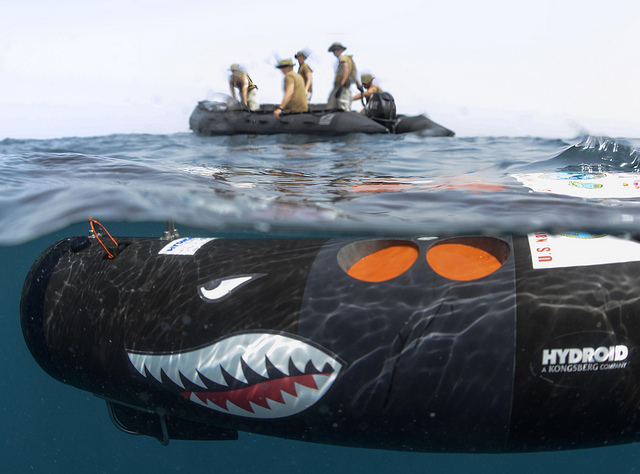
Sea State
Earlier this week, tensions between the US and Iran in the Gulf of Aden eased when Iranian vessels suspected of carrying arms for the Houthi rebels in Yemen began a slow retreat towards their home port. The USS Theodore Roosevelt is now headed for the Arabian Gulf, while the nine Iranian ships are just off the coast of Oman.
The US Navy is set to deploy its first underwater drones by the end of the year, according to military.com. The drones—REMUS 600 Autonomous Underwater Vehicles—will be installed on the USN’s Virginia-class submarines. See The Diplomat’s discussion on the implications of the installation here. Also on US deployments, it’s been confirmed by USN Rear Admiral Charles Williams that two of the Navy’s Littoral Combat Ships will be forward deployed to Singapore from 2016.
Still in the Asia–Pacific, Chinese military websites released images of a model of a landing helicopter dock (LHD) amphibious assault ship last week, indicating potential design specifications and capabilities of the PLAN’s future amphibious vessel.
Finally, Defence Minister Kevin Andrews’ trip to Europe included a tour of the TKMS shipyards and meetings with his French and German counterparts. The meetings come on the back of a revelation that Japan was being dealt with on a government-to-government basis while dealings with fellow Future Submarine project contenders Germany and France were being pursued at a purely commercial level.
Flight Path
President Obama made big news last week when he apologised for US drone strikes which inadvertently killed two hostages (an American and an Italian) being held by al Qaeda in Pakistan. Despite launching a full review of the strike, Obama maintained that it was both legal and within the administration’s guidelines for using lethal weapons abroad and in counterterrorism operations. The incident raises questions about the limitations of intensive intelligence gathering, as well as the rules for ‘signature strikes’—that is, targeting individuals based on tell-tale al Qaeda behaviour as opposed to positive identification.
Saudi Arabia last week announced the end of their bombing campaign in Yemen—known as Operation Decisive Storm—to later launch Operation Restoring Hope, a new counterterrorism-focused phase. Mark Stout from War on the Rocks draws on WWII bombing strategies to provide some strategic and moral lessons for the Saudi air campaign in Yemen.
The F-35 is facing criticism again, this time thanks to a new report from the US Government Accountability Office which outlines significant lifetime affordability challenges. The report also found major weaknesses in the use of a concurrent development cycle which saw numerous companies independently manufacturing a range of individual components without a focus on compatibility.
Rapid Fire
This past weekend marked the 100th Anniversary of the ANZAC landing in Gallipoli. The Huffington Post paid tribute to the event with a ‘then and now’ gallery that juxtaposes images from 1915 and 2015. While there has been no shortage of commentary commemorating the memories and sacrifice of the ANZACs, Peter Hartcher argues that we are missing the most important part of honouring history and the lessons we haven’t learnt.
The Gallipoli memory has also reignited the debate on mental health in the ADF, with John Mendoza, the former chairman of the National Advisory Council on Mental Health, calling for increased investment in mental health research and PTSD treatment.
Finally, the display of capabilities in Islamic State’s most recent propaganda video has impressed some military analysts. One anonymous former British Special Forces officer is even quoted saying that Islamic State is ‘better trained, more motivated, better led and supported’ than Iraq forces.

